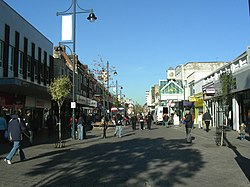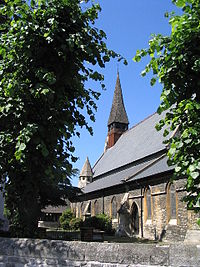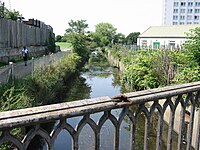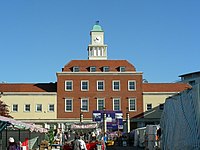Romford: Difference between revisions
| Line 38: | Line 38: | ||
==References== | ==References== | ||
{{Reflist}} | {{Reflist}} | ||
[[Category:Metropolitan Essex]] | |||
Revision as of 11:26, 25 January 2016
| Romford | |
| Essex | |
|---|---|
 South Street, Romford | |
| Location | |
| Grid reference: | TQ510887 |
| Location: | 51°34’36"N, -0°10’48"E |
| Data | |
| Population: | 36,500 (2005) |
| Post town: | Romford |
| Postcode: | RM1, RM7 |
| Dialling code: | 01708 |
| Local Government | |
| Council: | Havering |
| Parliamentary constituency: |
Romford |
Romford is a large suburban town in south-western Essex. Romford formed the administrative centre of the royal Liberty of Havering until it was dissolved in 1892.[1]
Good road links and the opening of the railway station in 1839 were key to the development of the town and the economic history of Romford is underpinned by a shift from agriculture to light industry and more recently to retail and commerce. As part of the suburban growth of London in the 20th century, Romford significantly expanded and increased in population. The town now forms one of the largest commercial, retail, entertainment and leisure districts outside central London.

Romford is first recorded in 1177 as Romfort, which is from Old English language rumford meaning "roomy ford".[2] The naming of the River Rom is a local 'back-formation' from the name of the town; the river is elsewhere known as the Beam. The ford most likely existed on the main London to Colchester road where it crossed that river.[2]
The town

The town centre is for the most part contained within a ring road formed of St Edwards Way, Mercury Gardens, Thurloe Gardens, Oldchurch Road and Waterloo Road. The market place and much of South Street and the High Street are pedestrianised. The railway cuts through the town from east to west on a viaduct, with the bulk of the central Romford area to its north.
The River Rom flows through the town in underground channels and joins the Thames after flowing through Hornchurch. Elsewhere along its course though the Rom is known as the River Beam.[2]
The expansion of the London conurbation crossed into Essex even in the nineteenth century and ribbon development reached as far as Romford in the 1930s.[3] The town is considered now to form part of the continuously built-up area from London, though blessed with a narrow green separation from unbroken townscape to the west. Romford is contiguous with Rush Green to the west, Collier Row to the north, Gidea Park to the east and Hornchurch to the south east.

Outside links
References
- ↑ The liberty of Havering-atte-Bower, A History of the County of Essex: Volume 7- Victoria County History
- ↑ 2.0 2.1 2.2 Mills, A.D. (2001). Dictionary of London Place Names. Oxford.
- ↑ Robson, William (1939). The Government and Mis-government of London. London: Allen & Unwin. pp. 26–27.